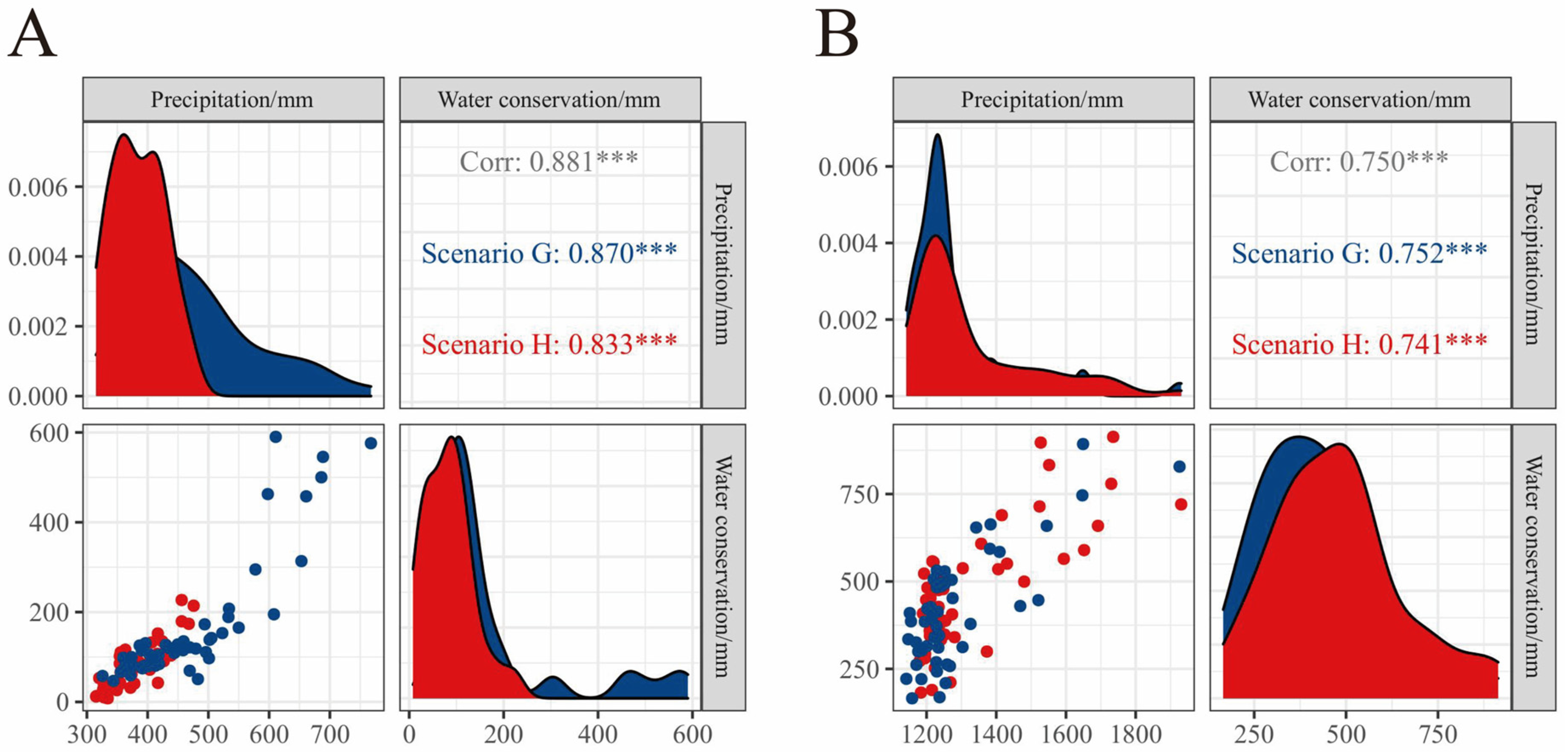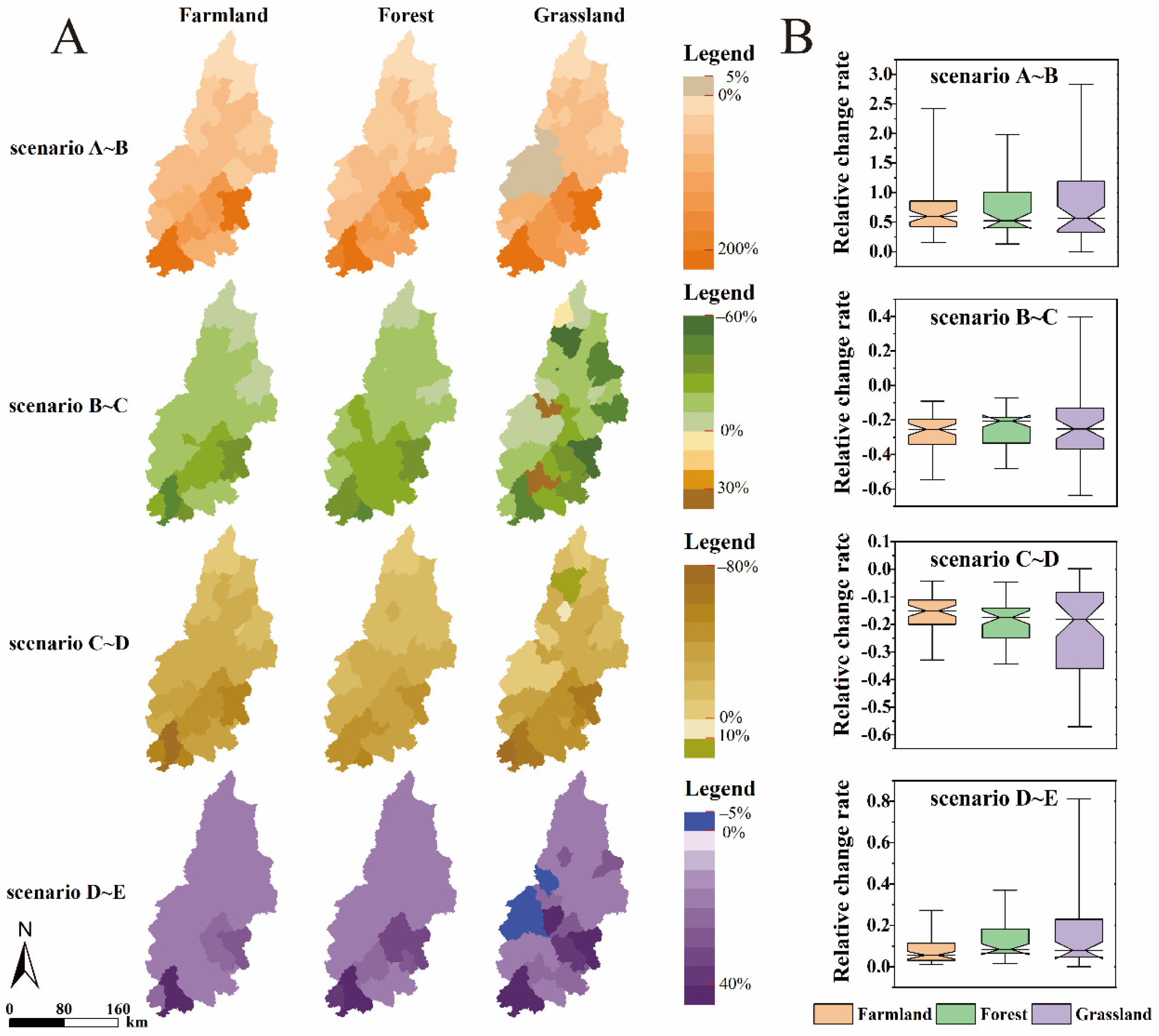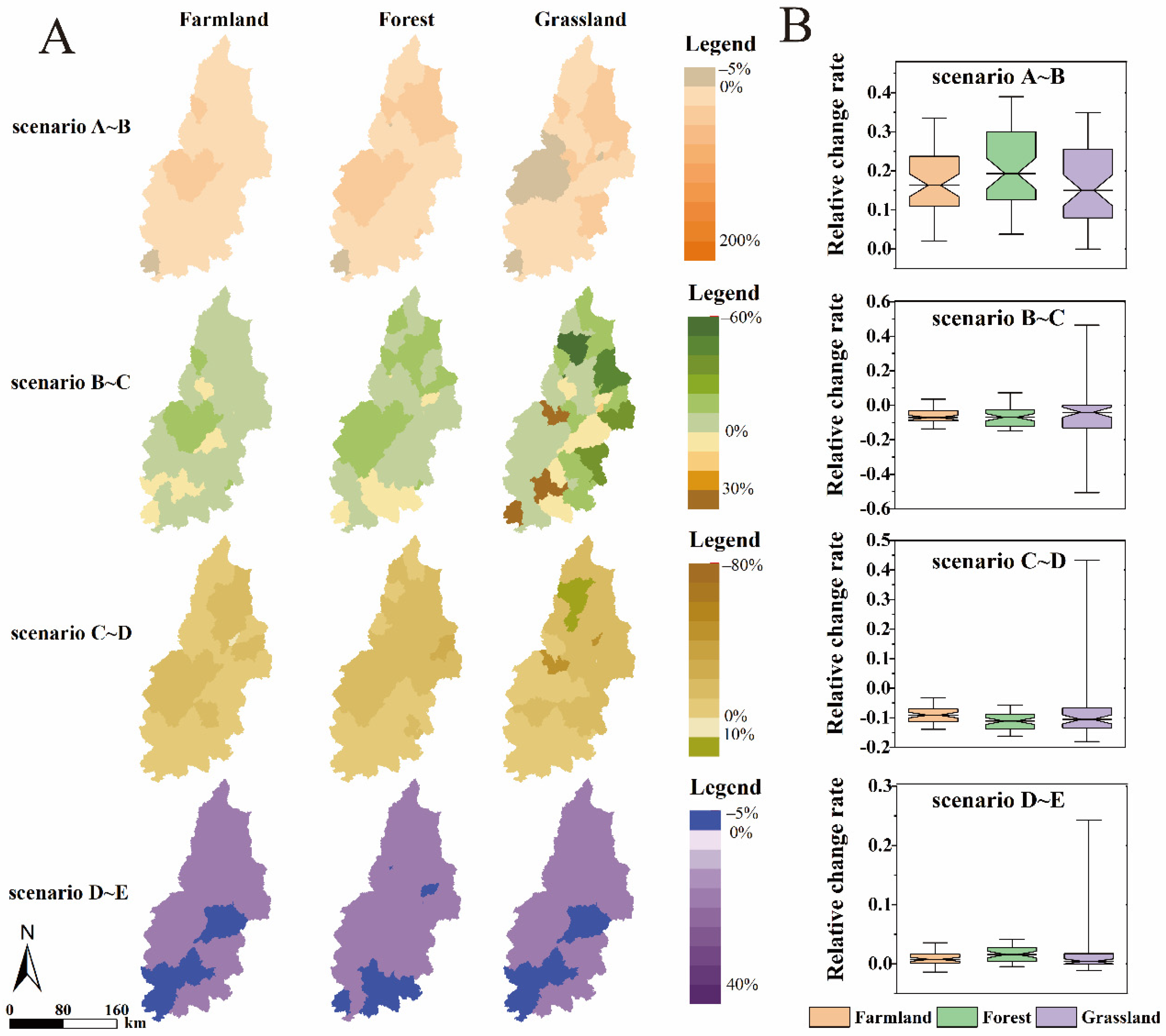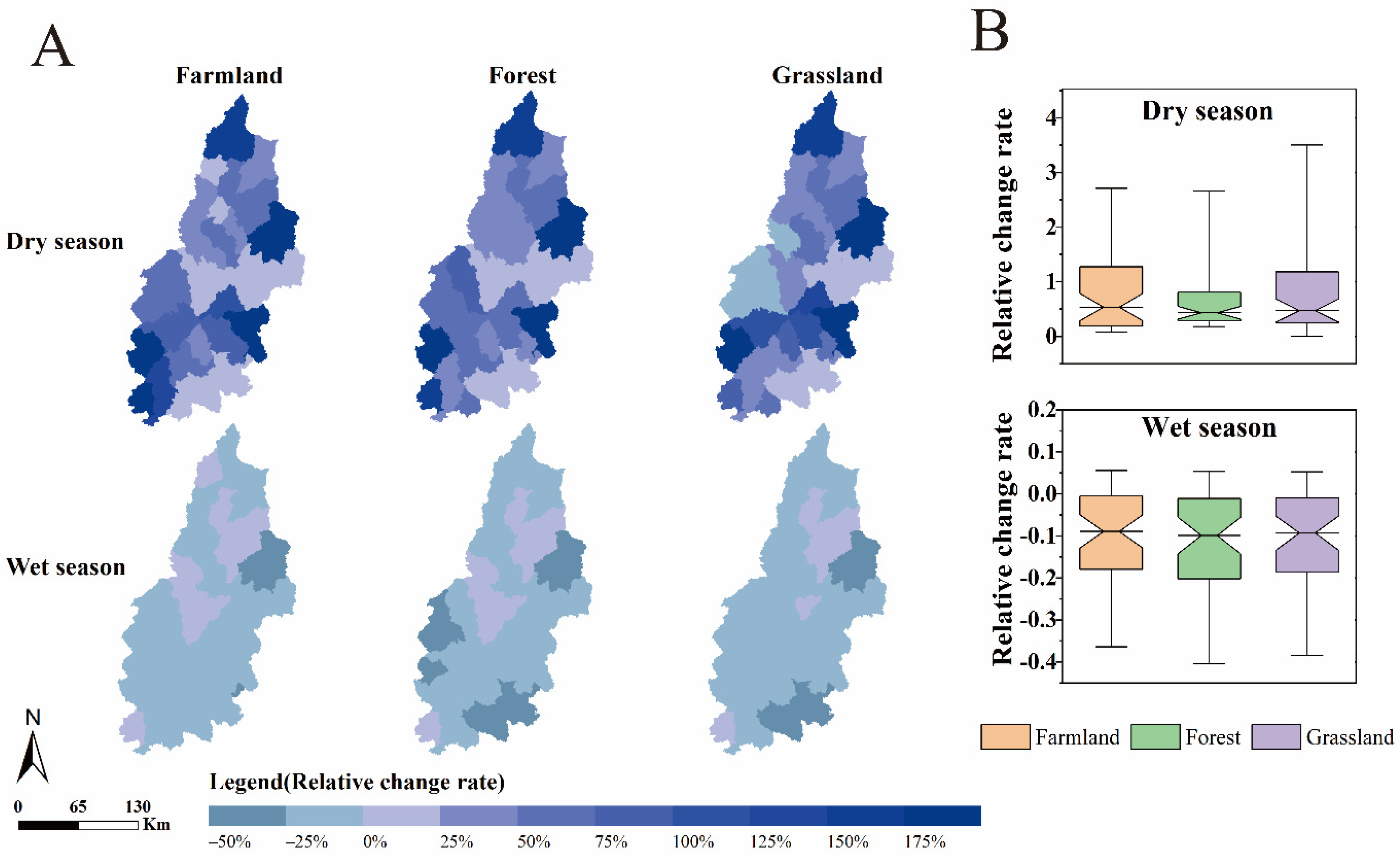Spatial and Temporal Evolution and Driving Mechanisms of Water Conservation Amount of Major Ecosystems in Typical Watersheds in Subtropical China
Abstract
:1. Introduction
2. Materials and Methods
2.1. Study Area
2.2. Materials
2.3. Simulation and Assessment of Water Source Nutrient Capacity
2.3.1. Construction and Evaluation of the Hydrological Model
2.3.2. Calculation of WCA
2.4. Driving Mechanisms of WCA Changes in a Changing Environment
2.4.1. Assessment of Land Use Change
- a.
- Land Use Transfer Matrix
- b.
- Land Use Level
- c.
- Land Use Dynamic Degree
2.4.2. Analysis Methods of the Driving Mechanism
- a.
- Statistical Analysis Method
- b.
- Scenario analysis
3. Results
3.1. Spatial Distribution Characteristics and Changes in the WCA of Major Ecosystems in the Hanjiang Watershed
3.2. An Investigation of the Driving Mechanisms of Changes in the WCA of Major Ecosystems under Changing Environmental Conditions
3.2.1. The Combined Impact of Land Use and Climate on WCA
3.2.2. Impact of Land Use Change on WCA of Major Ecosystems
3.2.3. Impact of Climate Change on WCA of Major Ecosystems
4. Discussion
5. Conclusions
Author Contributions
Funding
Data Availability Statement
Acknowledgments
Conflicts of Interest
References
- Costanza, R.; d’Arge, R.; De Groot, R.; Farber, S.; Grasso, M.; Hannon, B.; Limburg, K.; Naeem, S.; O’neill, R.V.; Paruelo, J. The value of the world’s ecosystem services and natural capital. Nature 1997, 387, 253–260. [Google Scholar] [CrossRef]
- Long, C.; Gaodi, X.; Changshun, Z.; Sha, P.; Na, F.; Liqiang, G.; Caixia, Z. Modelling ecosystem water supply services across the Lancang River Basin. J. Resour. Ecol. 2011, 2, 322–327. [Google Scholar] [CrossRef]
- Hu, W.; Li, G.; Gao, Z.; Jia, G.; Wang, Z.; Li, Y. Assessment of the impact of the Poplar Ecological Retreat Project on water conservation in the Dongting Lake wetland region using the InVEST model. Sci. Total Environ. 2020, 733, 139423. [Google Scholar] [CrossRef] [PubMed]
- Dennedy-Frank, P.J.; Muenich, R.L.; Chaubey, I.; Ziv, G. Comparing two tools for ecosystem service assessments regarding water resources decisions. J. Environ. Manag. 2016, 177, 331–340. [Google Scholar] [CrossRef] [PubMed] [Green Version]
- Xiao, Q.; Hu, D.; Xiao, Y. Assessing changes in soil conservation ecosystem services and causal factors in the Three Gorges Reservoir region of China. J. Clean. Prod. 2017, 163, S172–S180. [Google Scholar] [CrossRef]
- Schroter, D.; Cramer, W.; Leemans, R.; Prentice, I.C.; Araujo, M.B.; Arnell, N.W.; Bondeau, A.; Bugmann, H.; Carter, T.R.; Gracia, C.A.; et al. Ecosystem service supply and vulnerability to global change in Europe. Science 2005, 310, 1333–1337. [Google Scholar] [CrossRef] [Green Version]
- Carpenter, S.R.; Mooney, H.A.; Agard, J.; Capistrano, D.; DeFries, R.S.; Díaz, S.; Dietz, T.; Duraiappah, A.K.; Oteng-Yeboah, A.; Pereira, H.M. Science for managing ecosystem services: Beyond the Millennium Ecosystem Assessment. Proc. Natl. Acad. Sci. USA 2009, 106, 1305–1312. [Google Scholar] [CrossRef] [Green Version]
- Hoyer, R.; Chang, H. Assessment of freshwater ecosystem services in the Tualatin and Yamhill basins under climate change and urbanization. Appl. Geogr. 2014, 53, 402–416. [Google Scholar] [CrossRef]
- Xu, F.; Zhao, L.; Jia, Y.; Niu, C.; Liu, X.; Liu, H. Evaluation of water conservation function of Beijiang River basin in Nanling Mountains, China, based on WEP-L model. Ecol. Indic. 2022, 134, 108383. [Google Scholar] [CrossRef]
- Foley, J.A.; Defries, R.; Asner, G.P.; Barford, C.; Bonan, G.; Carpenter, S.R.; Chapin, F.S.; Coe, M.T.; Daily, G.C.; Gibbs, H.K.; et al. Global consequences of land use. Science 2005, 309, 570–574. [Google Scholar] [CrossRef]
- Chillo, V.; Vázquez, D.P.; Amoroso, M.M.; Bennett, E.M.; Koricheva, J. Land-use intensity indirectly affects ecosystem services mainly through plant functional identity in a temperate forest. Funct. Ecol. 2018, 32, 1390–1399. [Google Scholar] [CrossRef] [Green Version]
- Bai, Y.; Ochuodho, T.O.; Yang, J. Impact of land use and climate change on water-related ecosystem services in Kentucky, USA. Ecol. Indic. 2019, 102, 51–64. [Google Scholar] [CrossRef]
- Ouyang, Z.; Zheng, H.; Xiao, Y.; Polasky, S.; Liu, J.; Xu, W.; Wang, Q.; Zhang, L.; Xiao, Y.; Rao, E. Improvements in ecosystem services from investments in natural capital. Science 2016, 352, 1455–1459. [Google Scholar] [CrossRef] [PubMed]
- Duan, K.; Sun, G.; Sun, S.; Caldwell, P.V.; Cohen, E.C.; McNulty, S.G.; Aldridge, H.D.; Zhang, Y. Divergence of ecosystem services in U.S. National Forests and Grasslands under a changing climate. Sci. Rep. 2016, 6, 24441. [Google Scholar] [CrossRef] [PubMed] [Green Version]
- Sun, G.; Caldwell, P.V.; McNulty, S.G. Modelling the potential role of forest thinning in maintaining water supplies under a changing climate across the conterminous United States. Hydrol. Process. 2015, 29, 5016–5030. [Google Scholar] [CrossRef]
- Wang, J.; Wu, T.; Li, Q.; Wang, S. Quantifying the effect of environmental drivers on water conservation variation in the eastern Loess Plateau, China. Ecol. Indic. 2021, 125, 107493. [Google Scholar] [CrossRef]
- Xu, J.; Xie, G.; Xiao, Y.; Li, N.; Yu, F.; Pei, S.; Jiang, Y. Dynamic Analysis of Ecological Environment Quality Combined with Water Conservation Changes in National Key Ecological Function Areas in China. Sustainability 2018, 10, 1202. [Google Scholar] [CrossRef] [Green Version]
- Li, Z.; Huang, B.; Qiu, J.; Cai, Y.; Yang, Z.; Chen, S. Analysis on evolution characteristics of ecological flow of Hanjiang River under changing environment. Water Resour. Prot 2021, 37, 22–29. [Google Scholar] [CrossRef]
- Li, Y.; Deng, J.; Zang, C.; Kong, M.; Zhao, J. Spatial and temporal evolution characteristics of water resources in the Hanjiang River Basin of China over 50 years under a changing environment. Front. Environ. Sci. 2022, 10, 1377. [Google Scholar] [CrossRef]
- Li, M.; Liang, D.; Xia, J.; Song, J.; Cheng, D.; Wu, J.; Cao, Y.; Sun, H.; Li, Q. Evaluation of water conservation function of Danjiang River Basin in Qinling Mountains, China based on InVEST model. J. Environ. Manag. 2021, 286, 112212. [Google Scholar] [CrossRef]
- Arnold, J.G.; Srinivasan, R.; Muttiah, R.S.; Williams, J.R. Large area hydrologic modeling and assessment part I: Model devel-opment 1. JAWRA J. Am. Water Resour. Assoc. 1998, 34, 73–89. [Google Scholar] [CrossRef]
- Cong, W.; Sun, X.; Guo, H.; Shan, R. Comparison of the SWAT and InVEST models to determine hydrological ecosystem service spatial patterns, priorities and trade-offs in a complex basin. Ecol. Indic. 2020, 112, 106089. [Google Scholar] [CrossRef]
- Arnold, J.G.; Moriasi, D.N.; Gassman, P.W.; Abbaspour, K.C.; White, M.J.; Srinivasan, R.; Santhi, C.; Harmel, R.; Van Griensven, A.; Van Liew, M.W. SWAT: Model use, calibration, and validation. Trans. ASABE 2012, 55, 1491–1508. [Google Scholar] [CrossRef]
- Yang, J.; Reichert, P.; Abbaspour, K.C.; Xia, J.; Yang, H. Comparing uncertainty analysis techniques for a SWAT application to the Chaohe Basin in China. J. Hydrol. 2008, 358, 1–23. [Google Scholar] [CrossRef]
- Knoben, W.J.M.; Freer, J.E.; Woods, R.A. Technical note: Inherent benchmark or not? Comparing Nash–Sutcliffe and Kling–Gupta efficiency scores. Hydrol. Earth Syst. Sci. 2019, 23, 4323–4331. [Google Scholar] [CrossRef] [Green Version]
- Zhai, R.; Tao, F.; Xu, Z. Spatial–temporal changes in runoff and terrestrial ecosystem water retention under 1.5 and 2 °C warming scenarios across China. Earth Syst. Dyn. 2018, 9, 717–738. [Google Scholar] [CrossRef] [Green Version]
- Lu, X.; Zang, C.; Burenina, T. Study on the variation in evapotranspiration in different period of the Genhe River Basin in China. Phys. Chem. Earth Parts A/B/C 2020, 120, 102902. [Google Scholar] [CrossRef]
- Senthilnathan, S. Usefulness of Correlation Analysis. 2019. Available online: https://doi.org/10.2139/ssrn.3416918 (accessed on 5 December 2022).
- Wu, X.; Shi, W.; Guo, B.; Tao, F. Large spatial variations in the distributions of and factors affecting forest water retention capacity in China. Ecol. Indic. 2020, 113, 106152. [Google Scholar] [CrossRef]
- Yin, L.; Tao, F.; Zhai, R.; Chen, Y.; Hu, J.; Wang, Z.; Fu, B. Impacts of Future Climate Change and Atmospheric CO2 Concen-tration on Ecosystem Water Retention Service. Earth’s Future 2022, 10, e2021EF002138. [Google Scholar] [CrossRef]
- Zhang, Z.; Xia, F.; Yang, D.; Huo, J.; Wang, G.; Chen, H. Spatiotemporal characteristics in ecosystem service value and its interaction with human activities in Xinjiang, China. Ecol. Indic. 2020, 110, 105826. [Google Scholar] [CrossRef]
- Brown, A.E.; Zhang, L.; McMahon, T.A.; Western, A.W.; Vertessy, R.A. A review of paired catchment studies for determining changes in water yield resulting from alterations in vegetation. J. Hydrol. 2005, 310, 28–61. [Google Scholar] [CrossRef]
- Zang, C.; Liu, J. Trend analysis for the flows of green and blue water in the Heihe River basin, northwestern China. J. Hydrol. 2013, 502, 27–36. [Google Scholar] [CrossRef]
- Bolund, P.; Hunhammar, S. Ecosystem services in urban areas. Ecol. Econ. 1999, 29, 293–301. [Google Scholar] [CrossRef]
- Wen, Z.; Zheng, H.; Smith, J.R.; Zhao, H.; Liu, L.; Ouyang, Z. Functional diversity overrides community-weighted mean traits in linking land-use intensity to hydrological ecosystem services. Sci. Total Environ. 2019, 682, 583–590. [Google Scholar] [CrossRef]
- Felipe-Lucia, M.R.; Soliveres, S.; Penone, C.; Fischer, M.; Ammer, C.; Boch, S.; Boeddinghaus, R.S.; Bonkowski, M.; Buscot, F.; Fiore-Donno, A.M.; et al. Land-use intensity alters networks between biodiversity, ecosystem functions, and services. Proc. Natl. Acad. Sci. USA 2020, 117, 28140–28149. [Google Scholar] [CrossRef]
- Mendoza, K.; Mehta, V.M.; Daggupati, P.; Srinivasan, R.; Rosenberg, N.J.; Deb, D. High-Resolution Simulations of Decadal Climate Variability Impacts on Water Yield in the Missouri River Basin with the Soil and Water Assessment Tool (SWAT). J. Hydrometeorol. 2016, 17, 2455–2476. [Google Scholar] [CrossRef]
- Aznarez, C.; Jimeno-Sáez, P.; López-Ballesteros, A.; Pacheco, J.P.; Senent-Aparicio, J. Analysing the Impact of Climate Change on Hydrological Ecosystem Services in Laguna del Sauce (Uruguay) Using the SWAT Model and Remote Sensing Data. Remote Sens. 2021, 13, 2014. [Google Scholar] [CrossRef]
- Yang, D.; Liu, W.; Tang, L.; Chen, L.; Li, X.; Xu, X. Estimation of water provision service for monsoon catchments of South China: Applicability of the InVEST model. Landsc. Urban Plan. 2019, 182, 133–143. [Google Scholar] [CrossRef]
- Zhang, L.; Dawes, W.R.; Walker, G.R. Response of mean annual evapotranspiration to vegetation changes at catchment scale. Water Resour. Res. 2001, 37, 701–708. [Google Scholar] [CrossRef]
- Bruijnzeel, L.A. Hydrological functions of tropical forests: Not seeing the soil for the trees? Agric. Ecosyst. Environ. 2004, 104, 185–228. [Google Scholar] [CrossRef]
- Peña-Arancibia, J.L.; Bruijnzeel, L.A.; Mulligan, M.; van Dijk, A.I.J.M. Forests as ‘sponges’ and ‘pumps’: Assessing the impact of deforestation on dry-season flows across the tropics. J. Hydrol. 2019, 574, 946–963. [Google Scholar] [CrossRef]
- Jackson, R.B.; Jobbagy, E.G.; Avissar, R.; Roy, S.B.; Barrett, D.J.; Cook, C.W.; Farley, K.A.; le Maitre, D.C.; McCarl, B.A.; Murray, B.C. Trading water for carbon with biological carbon sequestration. Science 2005, 310, 1944–1947. [Google Scholar] [CrossRef] [Green Version]
- Piao, S.; Friedlingstein, P.; Ciais, P.; de Noblet-Ducoudré, N.; Labat, D.; Zaehle, S. Changes in climate and land use have a larger direct impact than rising CO2 on global river runoff trends. Proc. Natl. Acad. Sci. USA 2007, 104, 15242–15247. [Google Scholar] [CrossRef] [PubMed] [Green Version]
- Zang, C.; Wu, M.; Zhang, J.; Yue, Y. Research on the chemical element transport characteristics of the larch forest ecosystem of Greater Xing’an Mountain in China. Phys. Chem. Earth Parts A/B/C 2020, 120, 102919. [Google Scholar] [CrossRef]
- Pickett, S.T.; Cadenasso, M.L. Landscape ecology: Spatial heterogeneity in ecological systems. Science 1995, 269, 331–334. [Google Scholar] [CrossRef] [PubMed]









| Scenario | Year | ||
|---|---|---|---|
| Land Use Data | Meteorological Data | ||
| Land use change | A | 1980 | 1970–2020 |
| B | 1990 | 1970–2020 | |
| C | 2000 | 1970–2020 | |
| D | 2010 | 1970–2020 | |
| E | 2020 | 1970–2020 | |
| Climate change | F | 2020 | 1971–1980 |
| G | 2020 | 2011–2020 | |
| Combined change | H | 1980 | 1971–1980 |
| G | 2020 | 2011–2020 | |
| Ecosystem Type | Scenario H | Scenario G | Average |
|---|---|---|---|
| Farmland Ecosystem | 99.77 | 103.42 | 101.60 |
| Forest Ecosystem | 103.57 | 109.12 | 106.35 |
| Grassland Ecosystem | 77.49 | 83.25 | 80.37 |
| ALL | 280.84 | 295.79 | 288.32 |
| Independent Variable | Standardized Regression Coefficients (β) | Level of Significance (P) | |||
|---|---|---|---|---|---|
| Scenario H | Scenario G | Scenario H | Scenario G | ||
| Dry season | Precipitation | 0.870 | 0.860 | *** | *** |
| Evapotranspiration | −0.223 | 0.079 | |||
| Land use level | 0.064 | 0.090 | |||
| R2 | 0.756 | 0.768 | |||
| Wet season | Precipitation | 0.714 | 0.731 | *** | *** |
| Evapotranspiration | −0.097 | −0.212 | |||
| Land use level | 0.084 | 0.089 | |||
| R2 | 0.563 | 0.623 | |||
Disclaimer/Publisher’s Note: The statements, opinions and data contained in all publications are solely those of the individual author(s) and contributor(s) and not of MDPI and/or the editor(s). MDPI and/or the editor(s) disclaim responsibility for any injury to people or property resulting from any ideas, methods, instructions or products referred to in the content. |
© 2023 by the authors. Licensee MDPI, Basel, Switzerland. This article is an open access article distributed under the terms and conditions of the Creative Commons Attribution (CC BY) license (https://creativecommons.org/licenses/by/4.0/).
Share and Cite
Li, Y.; Kong, M.; Zang, C.; Deng, J. Spatial and Temporal Evolution and Driving Mechanisms of Water Conservation Amount of Major Ecosystems in Typical Watersheds in Subtropical China. Forests 2023, 14, 93. https://doi.org/10.3390/f14010093
Li Y, Kong M, Zang C, Deng J. Spatial and Temporal Evolution and Driving Mechanisms of Water Conservation Amount of Major Ecosystems in Typical Watersheds in Subtropical China. Forests. 2023; 14(1):93. https://doi.org/10.3390/f14010093
Chicago/Turabian StyleLi, Yiting, Ming Kong, Chuanfu Zang, and Jinglin Deng. 2023. "Spatial and Temporal Evolution and Driving Mechanisms of Water Conservation Amount of Major Ecosystems in Typical Watersheds in Subtropical China" Forests 14, no. 1: 93. https://doi.org/10.3390/f14010093





